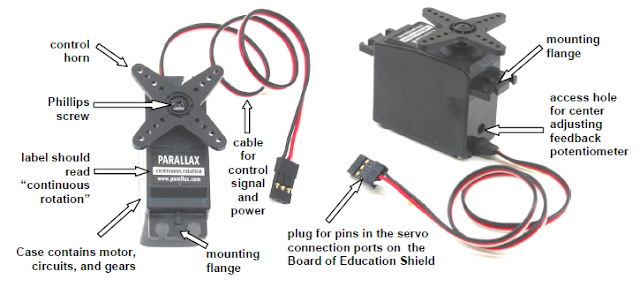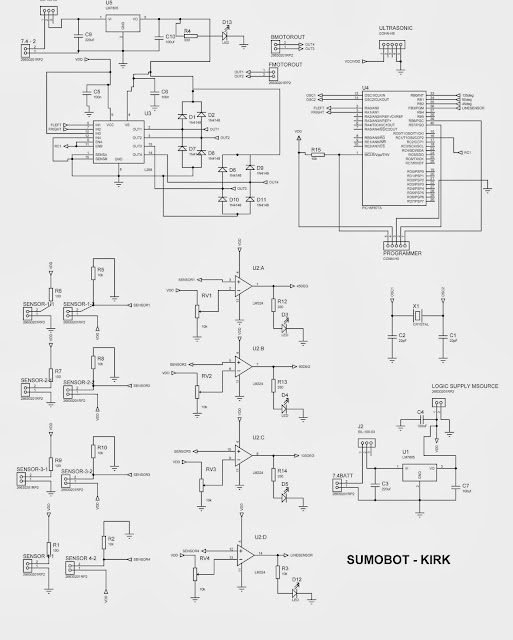The image shown below is the GPS Shield module that I used for my project. You may be able to purchase this module at http://www.e-gizmo.com/KIT/gps%20shield.html for 1,385 pesos.
An image below that is shown is the circuit diagram for the connection of the devices which are the GPS Shield, the MCU PIC16F877A and lastly the 2x16 LCD.
As I said earlier, I used a "2x16" LCD and the image shown here is a"2x14" LCD. This is because i used proteus for circuit design and simulation and the 15 and 16 are neglected due to the built in function of the device. In actual, the pin 15 is the anode and the 16 is the cathode. The purpose of pin 15 and 16 is that it turns on the LED/light background of the LCD. To attain this, simply connect pin 15 of the LCD to the 5VDC source and the pin 16 to the GND.
As for the TX and RX connection, only connect the Rx of the GPS to the Rx of the PIC16F877A, We will neglect the TX since we would only retrieve the information of the latitude and longitude.
Here is the program code I have made for this project:
NOTE: The programming software i used is the MikroC PIC Pro. In order for this to work, you need to download the MikroC PIC Pro and download the NMEA library function in order for you to be able to utilize some functions used for the GPS Shield. The NMEA library can be downloaded here : http://www.libstock.com/projects/view/695/nmea-library
/*---------------------------FLEET MANAGEMENT SYSTEM-------------------------
MikroC Programming by Kirk
----------------------------------------------------------------------------*/
// LCD module connections
sbit LCD_RS at RB4_bit;
sbit LCD_EN at RB5_bit;
sbit LCD_D4 at RB0_bit;
sbit LCD_D5 at RB1_bit;
sbit LCD_D6 at RB2_bit;
sbit LCD_D7 at RB3_bit;
sbit LCD_RS_Direction at TRISB4_bit;
sbit LCD_EN_Direction at TRISB5_bit;
sbit LCD_D4_Direction at TRISB0_bit;
sbit LCD_D5_Direction at TRISB1_bit;
sbit LCD_D6_Direction at TRISB2_bit;
sbit LCD_D7_Direction at TRISB3_bit;
// End LCD module connections
char txt5[] = "GPS with PIC877A";
char txt6[] = "F.M.S.";
// Variables
int i = 0;
int received = 0;
char DataType[] = "GPXXX";
char NMEA[] = "$xxxxx,xxxxxxxxx,xxxx.xxx,x,xxxxx.xxx,x,x,xx,x.x,xxx.x,x,xx.x,x,,*xx";
char receive;
// End Variables
void main(){
Lcd_Init(); // Initialize LCD
Lcd_Cmd(_LCD_CURSOR_OFF); // Cursor off
Lcd_Out(1,1,txt5); // Write text in first row
Lcd_Out(2,6,txt6); //displays txt5
Delay_ms(5000); //displays txt6
Lcd_Cmd(_LCD_CLEAR); // Clear display
Delay_ms(250);
UART1_Init(9600); // Initialize UART for GPS board connectivity
//LCD Stuff
LCD_Out(1,1, "Lat: ");
LCD_Out(2,1, "Lon: ");
LCD_Chr(1, 7, 0x20); //Degree Character
//LCD_Chr(2, 8, 0xB0); //Degree Character
LCD_Chr(2, 8, 0x20); //' Character
LCD_Chr(2, 11, 0x2E); //' Character
//End of LCD
while(1) {
if (UART1_Data_Ready() == 1) {
receive = UART1_Read();
if (receive == '$') // Check if sentence begins.
{
received = 0;
do{
if (UART1_Data_Ready() == 1)
{
UART1_Read_Text(DataType, ",", 10); // Capture GPXXX word
received = 1;
}
} while(received == 0);
// If it is GPGGA Data, then acquire it.
if ((DataType[2] == 'G') && (DataType[3] == 'G') && (DataType[4] == 'A'))
{
received = 0;
do{
if (UART1_Data_Ready() == 1)
{
UART1_Read_Text(NMEA, "*", 100); // Stop at *XX checksum data
received = 1;
}
} while(received == 0);
// Fill LCD with relevant data */
// Latitude
LCD_Chr(1, 5, NMEA[11]);
LCD_Chr(1, 6, NMEA[12]);
LCD_Chr(1, 8, NMEA[13]);
LCD_Chr(1, 9, NMEA[14]);
LCD_Chr(1, 10, NMEA[15]);
LCD_Chr(1, 11, NMEA[16]);
LCD_Chr(1, 12, NMEA[17]);
LCD_Chr(1, 13, NMEA[18]);
LCD_Chr(1, 14, NMEA[19]);
//LCD_Chr(1, 15, NMEA[20]);
LCD_Chr(1, 16, NMEA[21]);
// Longitude
LCD_Chr(2, 5, NMEA[23]);
LCD_Chr(2, 6, NMEA[24]);
LCD_Chr(2, 7, NMEA[25]);
LCD_Chr(2, 9, NMEA[26]);
LCD_Chr(2, 10, NMEA[27]);
LCD_Chr(2, 12, NMEA[29]);
LCD_Chr(2, 13, NMEA[30]);
LCD_Chr(2, 14, NMEA[31]);
LCD_Chr(2, 15, NMEA[32]);
LCD_Chr(2, 16, NMEA[34]);
//LCD_Chr(2, 15, NMEA[35]);
}
receive = "x";
}
}
}
}
Here are some images of this project and its actual video footage:
Project made by: Kirk Benedict P. Macaraeg




























